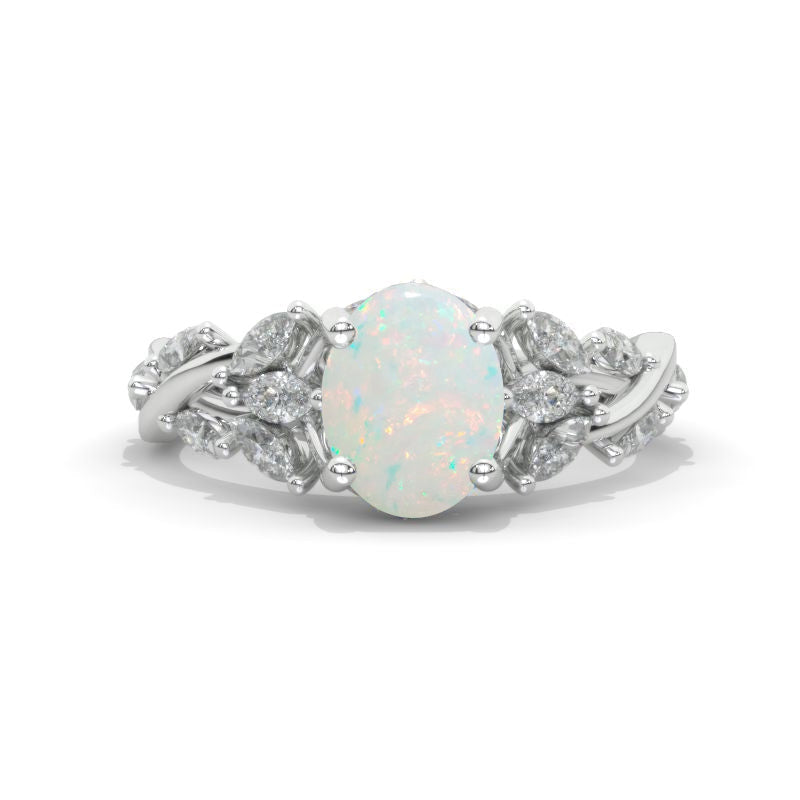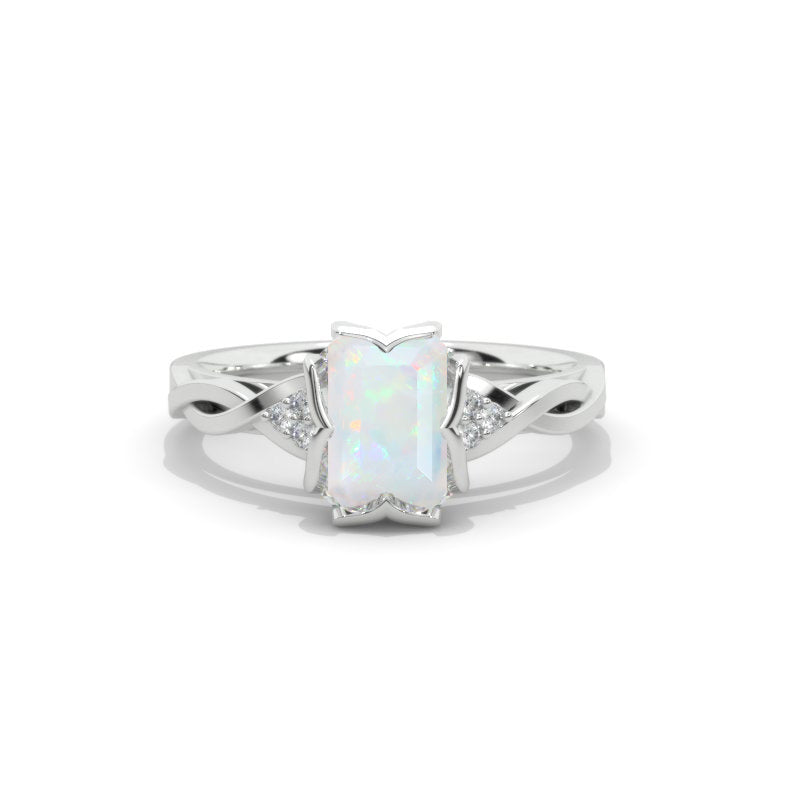Amethyst vs Alexandrite: Key Differences Between the Two Gemstones

Purple gemstones have always held special appeal in jewelry, but amethyst and alexandrite couldn't be more different despite sometimes appearing similar at first glance. One is affordable and widely available, the other rare and expensive. One maintains consistent color, the other literally changes before your eyes. If you're deciding between amethyst and alexandrite for an engagement ring or special piece, understanding what sets them apart helps you make the right choice.
The Basic Breakdown
Amethyst is the purple variety of quartz, one of the most common minerals on earth. It ranges from pale lilac to deep purple, sometimes with reddish or bluish undertones.
Alexandrite is a variety of chrysoberyl, famous for its color-changing properties. It appears green or bluish-green in daylight and shifts to purplish-red or raspberry under incandescent light. This dramatic transformation is alexandrite's signature characteristic.
Right away, you can see these stones serve different purposes. Amethyst offers consistent, beautiful purple. Alexandrite delivers one of nature's most mesmerizing optical phenomena.
Color: The Fundamental Difference
Amethyst's Stable Purple
Amethyst maintains its color regardless of lighting conditions. The shade varies between stones – some are pale lavender, others deep grape purple – but any individual amethyst looks the same in sunlight, indoor lighting, or candlelight.
The purple comes from iron impurities and natural irradiation within the quartz structure. Higher iron content and more radiation exposure create deeper, more saturated purples.
Color range: Light lilac to deep purple, sometimes with pink or reddish flashes
Most valuable shades: Medium to medium-dark purple with strong saturation, no brown or gray tones
Consistency: 100% stable across all lighting
Alexandrite's Color-Changing Magic
This is where alexandrite becomes extraordinary. The stone appears one color in daylight and completely different under incandescent bulbs. This phenomenon, called the "alexandrite effect," results from how chromium within the crystal structure absorbs light.
Daylight appearance: Green, bluish-green, or teal
Incandescent light appearance: Purplish-red, raspberry, or brownish-red
Quality indicator: The more dramatic the color shift, the more valuable the stone. Top alexandrites show vivid green to rich red transformations.
Fine alexandrite can shift so dramatically that people seeing it for the first time assume you've switched stones. The effect is that striking.
Poor-quality alexandrite shows minimal color change – maybe slight grayish-green to muddy purplish-brown. These stones still technically qualify as alexandrite but lack the magic that makes the gem special.
Rarity and Availability
Amethyst: Abundant and Accessible
Amethyst deposits exist worldwide – Brazil, Uruguay, Zambia, Arizona, and numerous other locations. Large, clean specimens are readily available. You can find beautiful amethysts in virtually any size.
This abundance translates to affordability. Even large, high-quality amethysts remain reasonably priced compared to rare gemstones.
Market availability: Excellent across all sizes and qualities
Finding quality stones: Easy – most jewelers stock amethyst
Alexandrite: Genuinely Rare
Natural alexandrite ranks among the rarest gemstones. The specific geological conditions required for formation occur infrequently. Major sources include Russia (the Ural Mountains where it was discovered), Sri Lanka, Brazil, and East Africa, but production remains limited.
Fine alexandrite with strong color change is exceptionally scarce. Large stones (3+ carats) with excellent color shift are museum-quality finds.
Market availability: Limited, especially for stones showing strong color change
Finding quality stones: Difficult – many jewelers never stock natural alexandrite
Most alexandrite jewelry today features lab-created stones, which are chemically identical to natural alexandrite but grown in controlled environments. Lab alexandrite offers the color-changing effect at accessible prices.
Price Comparison: The Reality Check
Amethyst Pricing
Budget-friendly across the board.
Low-quality amethyst: $10-$30 per carat (pale color, visible inclusions)
Medium-quality amethyst: $30-$80 per carat (good color, eye-clean)
High-quality amethyst: $50-$150 per carat (deep saturated purple, excellent clarity)
Even exceptional amethysts rarely exceed $200 per carat. A stunning 3-carat amethyst ring might cost $300-$600 for the stone alone.
Alexandrite Pricing
Prepare for sticker shock.
Lab-created alexandrite: $200-$800 per carat (excellent color change possible)
Low-quality natural alexandrite: $1,000-$3,000 per carat (weak color change)
Medium-quality natural alexandrite: $5,000-$15,000 per carat (good color change)
High-quality natural alexandrite: $20,000-$50,000+ per carat (strong color change, good size)
Top specimens from Russian mines can exceed $100,000 per carat at auction. A 3-carat natural alexandrite with excellent characteristics might cost more than a house down payment.
The price gap between amethyst and alexandrite is enormous – we're talking 100x to 1,000x differences for comparable sizes.
Hardness and Durability

Amethyst
Mohs hardness: 7
Amethyst offers decent durability – harder than glass, tougher than most household materials. It's suitable for rings with reasonable care but not indestructible.
Scratch resistance: Good but not exceptional. Harder materials (sapphires, diamonds, most metal surfaces) can scratch amethyst.
Impact resistance: Moderate. Sharp blows can chip or fracture amethyst, especially at corners or edges.
Best for: Rings worn with awareness, earrings, pendants, bracelets with protective settings
Alexandrite
Mohs hardness: 8.5
Alexandrite is significantly tougher than amethyst. It ranks between corundum (sapphires and rubies at 9) and topaz (8), making it excellent for daily wear.
Scratch resistance: Excellent. Very few materials will scratch alexandrite in normal conditions.
Impact resistance: Very good. Chrysoberyl has excellent toughness – it resists breaking better than many harder stones.
Best for: Engagement rings, daily-wear jewelry, any high-impact situations
If durability is a priority, alexandrite wins decisively. The difference between 7 and 8.5 on the Mohs scale is more significant than the numbers suggest – each point represents increasing resistance geometrically, not arithmetically.
Origin and History
Amethyst's Ancient Legacy
Humans have prized amethyst for thousands of years. Ancient Greeks believed it prevented intoxication. Medieval European royalty used amethyst extensively in crowns and ceremonial jewelry before diamonds gained prominence.
Until large Brazilian deposits were discovered in the 19th century, amethyst was considered a precious stone on par with rubies and sapphires. Abundance changed its status to semi-precious, though the beauty remained unchanged.
Discovery: Known since ancient times
Cultural significance: Associated with royalty, spirituality, sobriety
Modern perception: Beautiful and accessible rather than rare and precious
Alexandrite's Recent Discovery
Alexandrite was discovered in Russia's Ural Mountains in the 1830s, supposedly on the birthday of Tsar Alexander II (hence the name). The stone immediately became associated with Russian imperial family.
The timing was perfect – alexandrite displayed Russia's military colors (green and red), making it a patriotic symbol. Russian aristocracy embraced it as the ultimate status gemstone.
Discovery: 1830s in Russia
Cultural significance: Russian imperial gem, associated with luxury and rarity
Modern perception: One of the world's rarest and most valuable gemstones
Alexandrite's relatively recent discovery means it lacks the extensive historical lore of amethyst, but its rarity created instant mystique.
Comparison Table: Amethyst vs Alexandrite
| Feature | Amethyst | Alexandrite |
|---|---|---|
| Mineral Family | Quartz | Chrysoberyl |
| Color | Purple (consistent) | Color-changing (green to red) |
| Mohs Hardness | 7 | 8.5 |
| Rarity | Common | Very rare (natural) |
| Price (per carat) | $10-$150 | $200-$50,000+ |
| Availability | Excellent | Limited (natural) |
| Durability | Good | Excellent |
| Color Stability | 100% stable | Changes with light source |
| Best For | Budget-conscious, purple lovers | Collectors, unique engagement rings |
| Resale Value | Low | High (natural stones) |
| Lab-Created Options | Uncommon (natural is cheap) | Common (natural is expensive) |
Symbolism and Meaning
Amethyst
February birthstone: Perfect for February babies seeking meaningful jewelry
Spiritual associations: Clarity, peace, spiritual awareness, protection from negative energy
Emotional qualities: Calm, balance, emotional healing
Anniversary stone: 6th wedding anniversary
Amethyst carries deep spiritual significance across cultures. If metaphysical properties matter to you, amethyst has thousands of years of associated meaning.
Alexandrite
June birthstone (alternative): Shares June with pearl and moonstone
Symbolic meanings: Balance, joy, prosperity, transformation
Emotional qualities: Adaptability, confidence, creativity
Anniversary stone: 55th wedding anniversary
Alexandrite's color-changing nature symbolizes balance between different aspects of life – logic and emotion, strength and vulnerability. The transformation represents personal growth and adaptability.
When to Choose Amethyst
Budget Priorities
If keeping costs reasonable matters, amethyst delivers stunning purple beauty without financial stress. You can afford larger stones, better settings, and higher-quality metalwork because the gemstone itself is affordable.
Purple Color Preference
Want consistent, beautiful purple in your jewelry? Amethyst is the answer. The color doesn't change, doesn't surprise, and reliably delivers that purple aesthetic you're seeking.
February Birthstone Significance
For February babies, amethyst is the traditional birthstone choice. The personal connection adds meaning beyond just appearance.
Larger Stones Desired
Dreaming of a 5-carat center stone? With amethyst, this is achievable without mortgaging your future. Large alexandrites cost astronomical amounts; large amethysts remain reasonable.
Spiritual or Metaphysical Interest
If crystal healing, meditation, or spiritual practices appeal to you, amethyst's ancient associations and extensive lore provide depth.
When to Choose Alexandrite
Wanting Something Truly Unique
Alexandrite's color change is conversation-starting. Every time lighting changes, your jewelry transforms. This dynamic quality makes alexandrite unforgettable.
Prioritizing Durability
For engagement rings or daily-wear pieces, alexandrite's 8.5 hardness provides peace of mind. The stone can handle real-world wear better than amethyst.
Investment Value
Natural alexandrite holds and increases value over time due to rarity. If jewelry is partially an investment, alexandrite makes sense (though lab-created alexandrite has minimal resale value, like most lab gems).
June Birthstone Connection
For June birthdays, alexandrite offers a distinctive alternative to pearls or moonstone.
Appreciation for Rarity
Some people value owning genuinely rare objects. Natural alexandrite satisfies this desire – you're wearing something most people will never own.
Lab-Created Acceptance
If you're open to lab-created stones, lab alexandrite offers the magical color change at amethyst-like prices. You get the phenomenon without the astronomical cost.
Care and Maintenance Differences
Caring for Amethyst
Cleaning: Warm soapy water and soft brush. Avoid ultrasonic cleaners (can enhance fractures) and steam cleaning.
Heat sensitivity: Prolonged exposure to direct sunlight or heat can fade color over time. Store away from windows and heat sources.
Impact protection: Remove before activities involving potential impacts – sports, heavy cleaning, construction work.
Chemical exposure: Keep away from harsh household chemicals and chlorine.
Caring for Alexandrite
Cleaning: More durable than amethyst. Warm soapy water works perfectly. Ultrasonic and steam cleaning are generally safe.
Heat sensitivity: Minimal concerns. Alexandrite withstands heat better than amethyst.
Impact protection: More resistant to chips and breaks, but reasonable care is still smart. Remove before activities where direct impact is likely.
Chemical exposure: More resistant than amethyst but still avoid unnecessary chemical exposure.
Overall, alexandrite requires less cautious handling than amethyst due to superior hardness and toughness.
Lab-Created Options
Lab Amethyst
Lab-grown amethyst exists but is uncommon because natural amethyst is already affordable. Most jewelers don't bother with synthetic amethyst when natural stones cost so little.
If you encounter lab amethyst, it should be priced lower than natural – maybe $5-$20 per carat versus $20-$100 for comparable natural stones.
Lab Alexandrite
Lab-created alexandrite is widely available and popular. It offers the color-changing effect at accessible prices – typically $200-$800 per carat depending on size and quality of color change.
Advantages of lab alexandrite:
- Dramatic color change at affordable prices
- Often superior clarity to natural stones
- Ethical and environmentally friendly
- Chemically identical to natural alexandrite
Considerations:
- Minimal resale value
- Some purists prefer natural stones
- Not as rare (though still special)
For most buyers, lab alexandrite makes excellent sense. You get the magic without the astronomical cost.
Making Your Choice
The amethyst versus alexandrite decision comes down to priorities:
Choose amethyst if you want:
- Consistent, beautiful purple
- Budget-friendly pricing
- Large stones without financial stress
- Traditional purple gemstone elegance
- February birthstone significance
Choose alexandrite if you want:
- Mesmerizing color-changing effect
- Superior durability for daily wear
- Genuine rarity (natural stones)
- Conversation-starting uniqueness
- Investment potential (natural stones)
Neither is "better" – they serve completely different purposes and appeal to different preferences.
The Bottom Line
Amethyst and alexandrite share purple hues in certain lighting but that's where similarities end. Amethyst delivers reliable purple beauty at accessible prices. Alexandrite offers one of nature's most remarkable optical phenomena with exceptional durability and rarity.
Your budget, style preferences, and what you value in jewelry guide the choice. Want stunning purple without breaking the bank? Amethyst is your stone. Want something that transforms before your eyes and stands up to daily wear? Alexandrite (particularly lab-created) deserves serious consideration.
Browse both amethyst and alexandrite jewelry to see them in person. The difference becomes immediately obvious – and which one calls to you becomes clear.
Leave a comment
Comments will be approved before showing up.
Also in Articles
 White Opal — The Radiant October Birthstone of Light and Mystery
White Opal — The Radiant October Birthstone of Light and Mystery
Why Choose White Opal for October
White opal symbolizes light, purity, and emotional depth, making it the perfect gift for anyone born in October — or for anyone drawn to its cosmic radiance. Whether you choose a handcrafted opal ring, a dainty opal pendant, or a pair of opal earrings, this gemstone always stands out as a statement of individuality and grace.





























